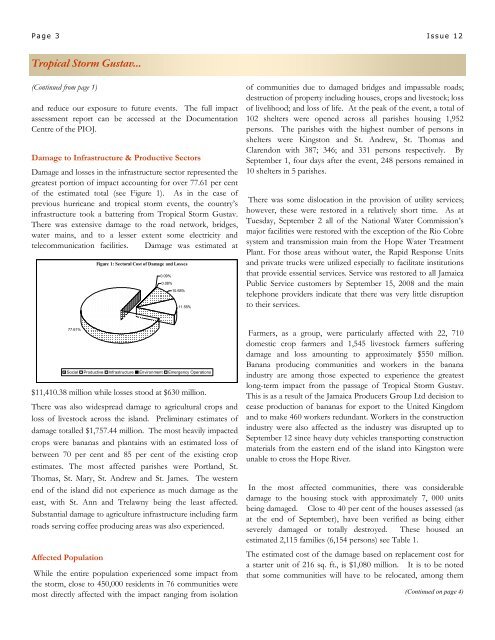Beginnings Issue 12.pub - Planning Institute of Jamaica
Beginnings Issue 12.pub - Planning Institute of Jamaica
Beginnings Issue 12.pub - Planning Institute of Jamaica
You also want an ePaper? Increase the reach of your titles
YUMPU automatically turns print PDFs into web optimized ePapers that Google loves.
P a g e 3 I s s u e 12<br />
Tropical Storm Gustav...<br />
(Continued from page 1)<br />
and reduce our exposure to future events. The full impact<br />
assessment report can be accessed at the Documentation<br />
Centre <strong>of</strong> the PIOJ.<br />
Damage to Infrastructure & Productive Sectors<br />
Damage and losses in the infrastructure sector represented the<br />
greatest portion <strong>of</strong> impact accounting for over 77.61 per cent<br />
<strong>of</strong> the estimated total (see Figure 1). As in the case <strong>of</strong><br />
previous hurricane and tropical storm events, the country’s<br />
infrastructure took a battering from Tropical Storm Gustav.<br />
There was extensive damage to the road network, bridges,<br />
water mains, and to a lesser extent some electricity and<br />
telecommunication facilities. Damage was estimated at<br />
Figure 1: Sectoral Cost <strong>of</strong> Damage and Losses<br />
0.09%<br />
0.08%<br />
10.68%<br />
11.55%<br />
<strong>of</strong> communities due to damaged bridges and impassable roads;<br />
destruction <strong>of</strong> property including houses, crops and livestock; loss<br />
<strong>of</strong> livelihood; and loss <strong>of</strong> life. At the peak <strong>of</strong> the event, a total <strong>of</strong><br />
102 shelters were opened across all parishes housing 1,952<br />
persons. The parishes with the highest number <strong>of</strong> persons in<br />
shelters were Kingston and St. Andrew, St. Thomas and<br />
Clarendon with 387; 346; and 331 persons respectively. By<br />
September 1, four days after the event, 248 persons remained in<br />
10 shelters in 5 parishes.<br />
There was some dislocation in the provision <strong>of</strong> utility services;<br />
however, these were restored in a relatively short time. As at<br />
Tuesday, September 2 all <strong>of</strong> the National Water Commission’s<br />
major facilities were restored with the exception <strong>of</strong> the Rio Cobre<br />
system and transmission main from the Hope Water Treatment<br />
Plant. For those areas without water, the Rapid Response Units<br />
and private trucks were utilized especially to facilitate institutions<br />
that provide essential services. Service was restored to all <strong>Jamaica</strong><br />
Public Service customers by September 15, 2008 and the main<br />
telephone providers indicate that there was very little disruption<br />
to their services.<br />
77.61%<br />
Social Productive Infrastructure Environment Emergency Operations<br />
$11,410.38 million while losses stood at $630 million.<br />
There was also widespread damage to agricultural crops and<br />
loss <strong>of</strong> livestock across the island. Preliminary estimates <strong>of</strong><br />
damage totalled $1,757.44 million. The most heavily impacted<br />
crops were bananas and plantains with an estimated loss <strong>of</strong><br />
between 70 per cent and 85 per cent <strong>of</strong> the existing crop<br />
estimates. The most affected parishes were Portland, St.<br />
Thomas, St. Mary, St. Andrew and St. James. The western<br />
end <strong>of</strong> the island did not experience as much damage as the<br />
east, with St. Ann and Trelawny being the least affected.<br />
Substantial damage to agriculture infrastructure including farm<br />
roads serving c<strong>of</strong>fee producing areas was also experienced.<br />
Affected Population<br />
While the entire population experienced some impact from<br />
the storm, close to 450,000 residents in 76 communities were<br />
most directly affected with the impact ranging from isolation<br />
Farmers, as a group, were particularly affected with 22, 710<br />
domestic crop farmers and 1,545 livestock farmers suffering<br />
damage and loss amounting to approximately $550 million.<br />
Banana producing communities and workers in the banana<br />
industry are among those expected to experience the greatest<br />
long-term impact from the passage <strong>of</strong> Tropical Storm Gustav.<br />
This is as a result <strong>of</strong> the <strong>Jamaica</strong> Producers Group Ltd decision to<br />
cease production <strong>of</strong> bananas for export to the United Kingdom<br />
and to make 460 workers redundant. Workers in the construction<br />
industry were also affected as the industry was disrupted up to<br />
September 12 since heavy duty vehicles transporting construction<br />
materials from the eastern end <strong>of</strong> the island into Kingston were<br />
unable to cross the Hope River.<br />
In the most affected communities, there was considerable<br />
damage to the housing stock with approximately 7, 000 units<br />
being damaged. Close to 40 per cent <strong>of</strong> the houses assessed (as<br />
at the end <strong>of</strong> September), have been verified as being either<br />
severely damaged or totally destroyed. These housed an<br />
estimated 2,115 families (6,154 persons) see Table 1.<br />
The estimated cost <strong>of</strong> the damage based on replacement cost for<br />
a starter unit <strong>of</strong> 216 sq. ft., is $1,080 million. It is to be noted<br />
that some communities will have to be relocated, among them<br />
(Continued on page 4)
















